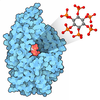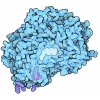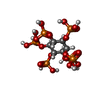[English] 日本語
 Yorodumi
Yorodumi- PDB-9dtq: The structure of HDAC2-CoREST in complex with KBTBD4R313PRR mutant -
+ Open data
Open data
- Basic information
Basic information
| Entry | Database: PDB / ID: 9dtq | ||||||
|---|---|---|---|---|---|---|---|
| Title | The structure of HDAC2-CoREST in complex with KBTBD4R313PRR mutant | ||||||
 Components Components |
| ||||||
 Keywords Keywords | LIGASE / protein degradation / E3 ligase / Neo-substrate / cancer mutation | ||||||
| Function / homology |  Function and homology information Function and homology informationpositive regulation of male mating behavior / protein de-2-hydroxyisobutyrylase activity / protein lysine delactylase activity / negative regulation of dendritic spine development / p75NTR negatively regulates cell cycle via SC1 / epidermal cell differentiation / positive regulation of megakaryocyte differentiation / histone decrotonylase activity / fungiform papilla formation / NuRD complex ...positive regulation of male mating behavior / protein de-2-hydroxyisobutyrylase activity / protein lysine delactylase activity / negative regulation of dendritic spine development / p75NTR negatively regulates cell cycle via SC1 / epidermal cell differentiation / positive regulation of megakaryocyte differentiation / histone decrotonylase activity / fungiform papilla formation / NuRD complex / positive regulation of interleukin-1 production / regulation of cell fate specification / behavioral response to ethanol / EGR2 and SOX10-mediated initiation of Schwann cell myelination / negative regulation of transcription by competitive promoter binding / negative regulation of stem cell population maintenance / histone deacetylase activity, hydrolytic mechanism / ESC/E(Z) complex / histone deacetylase / regulation of stem cell differentiation / cardiac muscle hypertrophy / cellular response to dopamine / STAT3 nuclear events downstream of ALK signaling / DNA repair complex / response to caffeine / protein lysine deacetylase activity / Hydrolases; Acting on carbon-nitrogen bonds, other than peptide bonds; In linear amides / histone deacetylase activity / embryonic digit morphogenesis / positive regulation of intracellular estrogen receptor signaling pathway / Notch-HLH transcription pathway / Sin3-type complex / histone deacetylase complex / odontogenesis of dentin-containing tooth / eyelid development in camera-type eye / positive regulation of stem cell population maintenance / dendrite development / histone methyltransferase complex / response to amyloid-beta / RNA Polymerase I Transcription Initiation / positive regulation of oligodendrocyte differentiation / positive regulation of proteolysis / Regulation of MECP2 expression and activity / progesterone receptor signaling pathway / response to hyperoxia / hair follicle placode formation / NF-kappaB binding / FOXO-mediated transcription of oxidative stress, metabolic and neuronal genes / cellular response to transforming growth factor beta stimulus / positive regulation of epithelial to mesenchymal transition / Transcriptional regulation of brown and beige adipocyte differentiation by EBF2 / MECP2 regulates neuronal receptors and channels / Regulation of TP53 Activity through Acetylation / cellular response to retinoic acid / heat shock protein binding / transcription repressor complex / negative regulation of cell migration / response to amphetamine / SUMOylation of chromatin organization proteins / Regulation of PTEN gene transcription / erythrocyte differentiation / ERCC6 (CSB) and EHMT2 (G9a) positively regulate rRNA expression / transcription coregulator binding / Regulation of endogenous retroelements by KRAB-ZFP proteins / response to nicotine / response to cocaine / HDACs deacetylate histones / Regulation of endogenous retroelements by Piwi-interacting RNAs (piRNAs) / promoter-specific chromatin binding / circadian regulation of gene expression / negative regulation of transforming growth factor beta receptor signaling pathway / NoRC negatively regulates rRNA expression / protein modification process / NOTCH1 Intracellular Domain Regulates Transcription / Constitutive Signaling by NOTCH1 PEST Domain Mutants / Constitutive Signaling by NOTCH1 HD+PEST Domain Mutants / histone deacetylase binding / cellular response to hydrogen peroxide / positive regulation of tumor necrosis factor production / transcription corepressor activity / heterochromatin formation / negative regulation of neuron projection development / cellular response to heat / Factors involved in megakaryocyte development and platelet production / chromatin organization / response to lipopolysaccharide / histone binding / transcription regulator complex / Potential therapeutics for SARS / RNA polymerase II-specific DNA-binding transcription factor binding / chromosome, telomeric region / chromatin remodeling / response to xenobiotic stimulus / negative regulation of gene expression / negative regulation of DNA-templated transcription / positive regulation of cell population proliferation / chromatin binding / regulation of transcription by RNA polymerase II / negative regulation of apoptotic process / chromatin Similarity search - Function | ||||||
| Biological species |  Homo sapiens (human) Homo sapiens (human) | ||||||
| Method | ELECTRON MICROSCOPY / single particle reconstruction / cryo EM / Resolution: 2.87 Å | ||||||
 Authors Authors | Xie, X. / Liau, B. / Zheng, N. | ||||||
| Funding support |  United States, 1items United States, 1items
| ||||||
 Citation Citation |  Journal: Nature / Year: 2025 Journal: Nature / Year: 2025Title: Converging mechanism of UM171 and KBTBD4 neomorphic cancer mutations. Authors: Xiaowen Xie / Olivia Zhang / Megan J R Yeo / Ceejay Lee / Ran Tao / Stefan A Harry / N Connor Payne / Eunju Nam / Leena Paul / Yiran Li / Hui Si Kwok / Hanjie Jiang / Haibin Mao / Jennifer L ...Authors: Xiaowen Xie / Olivia Zhang / Megan J R Yeo / Ceejay Lee / Ran Tao / Stefan A Harry / N Connor Payne / Eunju Nam / Leena Paul / Yiran Li / Hui Si Kwok / Hanjie Jiang / Haibin Mao / Jennifer L Hadley / Hong Lin / Melissa Batts / Pallavi M Gosavi / Vincenzo D'Angiolella / Philip A Cole / Ralph Mazitschek / Paul A Northcott / Ning Zheng / Brian B Liau /   Abstract: Cancer mutations can create neomorphic protein-protein interactions to drive aberrant function. As a substrate receptor of the CULLIN3-RING E3 ubiquitin ligase complex, KBTBD4 is recurrently mutated ...Cancer mutations can create neomorphic protein-protein interactions to drive aberrant function. As a substrate receptor of the CULLIN3-RING E3 ubiquitin ligase complex, KBTBD4 is recurrently mutated in medulloblastoma, the most common embryonal brain tumour in children. These mutations impart gain-of-function to KBTBD4 to induce aberrant degradation of the transcriptional corepressor CoREST. However, their mechanism remains unresolved. Here we establish that KBTBD4 mutations promote CoREST degradation through engaging HDAC1/2 as the direct target of the mutant substrate receptor. Using deep mutational scanning, we chart the mutational landscape of the KBTBD4 cancer hotspot, revealing distinct preferences by which insertions and substitutions can promote gain-of-function and the critical residues involved in the hotspot interaction. Cryo-electron microscopy analysis of two distinct KBTBD4 cancer mutants bound to LSD1-HDAC1-CoREST reveals that a KBTBD4 homodimer asymmetrically engages HDAC1 with two KELCH-repeat β-propeller domains. The interface between HDAC1 and one of the KBTBD4 β-propellers is stabilized by the medulloblastoma mutations, which insert a bulky side chain into the HDAC1 active site pocket. Our structural and mutational analyses inform how this hotspot E3-neosubstrate interface can be chemically modulated. First, we unveil a converging shape-complementarity-based mechanism between gain-of-function E3 mutations and a molecular glue degrader, UM171. Second, we demonstrate that HDAC1/2 inhibitors can block the mutant KBTBD4-HDAC1 interface and proliferation of KBTBD4-mutant medulloblastoma cells. Altogether, our work reveals the structural and mechanistic basis of cancer mutation-driven neomorphic protein-protein interactions. | ||||||
| History |
|
- Structure visualization
Structure visualization
| Structure viewer | Molecule:  Molmil Molmil Jmol/JSmol Jmol/JSmol |
|---|
- Downloads & links
Downloads & links
- Download
Download
| PDBx/mmCIF format |  9dtq.cif.gz 9dtq.cif.gz | 319.3 KB | Display |  PDBx/mmCIF format PDBx/mmCIF format |
|---|---|---|---|---|
| PDB format |  pdb9dtq.ent.gz pdb9dtq.ent.gz | 249 KB | Display |  PDB format PDB format |
| PDBx/mmJSON format |  9dtq.json.gz 9dtq.json.gz | Tree view |  PDBx/mmJSON format PDBx/mmJSON format | |
| Others |  Other downloads Other downloads |
-Validation report
| Summary document |  9dtq_validation.pdf.gz 9dtq_validation.pdf.gz | 1.3 MB | Display |  wwPDB validaton report wwPDB validaton report |
|---|---|---|---|---|
| Full document |  9dtq_full_validation.pdf.gz 9dtq_full_validation.pdf.gz | 1.3 MB | Display | |
| Data in XML |  9dtq_validation.xml.gz 9dtq_validation.xml.gz | 57.9 KB | Display | |
| Data in CIF |  9dtq_validation.cif.gz 9dtq_validation.cif.gz | 87 KB | Display | |
| Arichive directory |  https://data.pdbj.org/pub/pdb/validation_reports/dt/9dtq https://data.pdbj.org/pub/pdb/validation_reports/dt/9dtq ftp://data.pdbj.org/pub/pdb/validation_reports/dt/9dtq ftp://data.pdbj.org/pub/pdb/validation_reports/dt/9dtq | HTTPS FTP |
-Related structure data
| Related structure data |  47156MC  8vpqC  8vrtC M: map data used to model this data C: citing same article ( |
|---|---|
| Similar structure data | Similarity search - Function & homology  F&H Search F&H Search |
- Links
Links
- Assembly
Assembly
| Deposited unit | 
|
|---|---|
| 1 |
|
- Components
Components
| #1: Protein | Mass: 55311.961 Da / Num. of mol.: 1 Source method: isolated from a genetically manipulated source Source: (gene. exp.)  Homo sapiens (human) / Gene: HDAC2 / Production host: Homo sapiens (human) / Gene: HDAC2 / Production host:  References: UniProt: Q92769, histone deacetylase, Hydrolases; Acting on carbon-nitrogen bonds, other than peptide bonds; In linear amides | ||||||||
|---|---|---|---|---|---|---|---|---|---|
| #2: Protein | Mass: 58463.059 Da / Num. of mol.: 2 Source method: isolated from a genetically manipulated source Source: (gene. exp.)  Homo sapiens (human) / Gene: KBTBD4, BKLHD4 / Production host: Homo sapiens (human) / Gene: KBTBD4, BKLHD4 / Production host:  Trichoplusia ni (cabbage looper) / References: UniProt: Q9NVX7 Trichoplusia ni (cabbage looper) / References: UniProt: Q9NVX7#3: Protein | | Mass: 45974.441 Da / Num. of mol.: 1 Source method: isolated from a genetically manipulated source Source: (gene. exp.)  Homo sapiens (human) / Gene: RCOR1, KIAA0071, RCOR / Production host: Homo sapiens (human) / Gene: RCOR1, KIAA0071, RCOR / Production host:  Homo sapiens (human) / References: UniProt: Q9UKL0 Homo sapiens (human) / References: UniProt: Q9UKL0#4: Chemical | ChemComp-IHP / | Has ligand of interest | Y | Has protein modification | N | |
-Experimental details
-Experiment
| Experiment | Method: ELECTRON MICROSCOPY |
|---|---|
| EM experiment | Aggregation state: PARTICLE / 3D reconstruction method: single particle reconstruction |
- Sample preparation
Sample preparation
| Component | Name: LHC-KBTBD4PRRmutant / Type: COMPLEX / Entity ID: #1-#3 / Source: RECOMBINANT |
|---|---|
| Source (natural) | Organism:  Homo sapiens (human) Homo sapiens (human) |
| Source (recombinant) | Organism:  Homo sapiens (human) Homo sapiens (human) |
| Buffer solution | pH: 7.5 |
| Specimen | Embedding applied: NO / Shadowing applied: NO / Staining applied: NO / Vitrification applied: YES |
| Vitrification | Cryogen name: ETHANE |
- Electron microscopy imaging
Electron microscopy imaging
| Experimental equipment |  Model: Titan Krios / Image courtesy: FEI Company |
|---|---|
| Microscopy | Model: TFS KRIOS |
| Electron gun | Electron source:  FIELD EMISSION GUN / Accelerating voltage: 300 kV / Illumination mode: FLOOD BEAM FIELD EMISSION GUN / Accelerating voltage: 300 kV / Illumination mode: FLOOD BEAM |
| Electron lens | Mode: BRIGHT FIELD / Nominal defocus max: 1800 nm / Nominal defocus min: 800 nm |
| Image recording | Electron dose: 49 e/Å2 / Film or detector model: GATAN K3 (6k x 4k) |
- Processing
Processing
| EM software | Name: PHENIX / Version: 1.21_5207: / Category: model refinement | ||||||||||||||||||||||||
|---|---|---|---|---|---|---|---|---|---|---|---|---|---|---|---|---|---|---|---|---|---|---|---|---|---|
| CTF correction | Type: PHASE FLIPPING ONLY | ||||||||||||||||||||||||
| 3D reconstruction | Resolution: 2.87 Å / Resolution method: FSC 0.143 CUT-OFF / Num. of particles: 700385 / Symmetry type: POINT | ||||||||||||||||||||||||
| Refine LS restraints |
|
 Movie
Movie Controller
Controller




 PDBj
PDBj


































